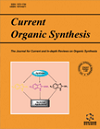- Home
- A-Z Publications
- Current Organic Synthesis
- Previous Issues
- Volume 9, Issue 3, 2012
Current Organic Synthesis - Volume 9, Issue 3, 2012
Volume 9, Issue 3, 2012
-
-
Supramolecular Host-Guest Asymmetric Induction In Organic Synthesis
More LessIn past decades, the pharmacopoeia was dominated by racemates, but since the emergence of new technologies in the 1990s that allowed the preparation of pure enantiomers in significant quantities, the awareness and interest in the stereochemistry of drug actions have increased. In this short review, the implementation of several hosts, guests, building blocks and methods in host-guest supramolecular chemistry was outli Read More
-
-
-
Stereoselective Synthesis of α-Aminophosphonic Acids Analogs of the 20 Proteinogenic α-Amino Acids
More LessAuthors: Mario Ordonez, Jose Luis Viveros-Ceballos, Carlos Cativiela and Alicia ArizpeThis review describes the synthesis, biological interest and importance of the α-aminophosphonic acids analogs of the 20 proteinogenic α-amino acids. Special attention is devoted to those stereoselective procedures that allow the synthesis of the required compounds in enantiomerically pure form.
-
-
-
Melamine Derivatives - A Review on Synthesis and Application
More LessAuthors: Klaus Bretterbauer and Clemens SchwarzingerMelamine (2,4,6-triamino-1,3,5-triazine) was first synthesized by Liebig in 1834 and its industrial application, starting with the development of melamine formaldehyde resins in the late 1930ies, has boomed since. In the last 80 years a vast number of different melamine derivatives have been prepared in order to provide structures for applications such as polymers, medicinal drugs, or biologically active compounds. It is t Read More
-
-
-
Pictet-Spengler Reaction Revisited: Engineering of Tetherd Biheterocycles into Annulated Polyheterocycles
More LessThis micro review focuses on the application of the modified Pictet-Spengler reaction to the synthesis of diverse polyheterocycles with structural resemblance to natural products. The modified Pictet-Spengler reaction takes use of tethered biheterocycles comprising nucleophilic partner and a source for electrophilic partner followed by their condensation with aldehydes/ketones to furnish annulated polyheterocycles. Using this Read More
-
-
-
Synthetic Strategies for the Construction of δ-Carbolines: A Chemical Ladder in Search of Novel Drugs
More Lessδ-Carboline and its naturally obtained analogs are of importance due to their wide range of biological properties. In the present review, we intend to discuss the main trends in the synthesis of δ-carboline analogs based on pyridine derivatives (including the Fischer synthesis, Graebe-Ullmann reaction, photochemical cyclization, arylation of substituted pyridines, quinolines, etc.) and indole derivatives in order to compare the po Read More
-
-
-
Olefin Metathesis as Key Step in the Synthesis of Bioactive Compounds: Challenges in the Total Synthesis of (-)-Kendomycin
More LessIn this short review article, we highlight the application of the olefin metathesis reaction as a key step in the total synthesis of (-)-kendomycin, a macrocyclic polyketide ansamycin exhibiting pronounced activity as an endothelin receptor antagonist and antiosteoporotic agent, as well as important antibiotic potency against multiresistant bacteria and remarkable cytotoxicity versus a series of human tumour cell lines. By s Read More
-
-
-
Facile Synthesis and Antimicrobial Evaluation of New Chiral Macrocyclic Hydrazone and Tricyclopolyazacarboxamide Candidates Incorporating Amino Acid and Pyridine Moieties
More LessAuthors: Osama I. Abd El-Salam, Mohamed A. Al-Omar and Abd El-Galil E. AmrA series of macrocyclic Schiff-bases and hexadecaazatricyclo-carboxamides has been prepared via the cyclocondensation of pyridine-2,6-dicarbonyl dichloride (1) or pyridine-2,6-dicarboxylic acid dihydrazide (3) or N,N-bis-[1- hydrazinyl-2-(substituted)]-pyridine-2,6-dicarboxamides (5a-d) with appropriate difunctional reagents. The coupling of 3 with tertacarboxylic acid dianhydride gave the macrocyclic tetraimidetetrac Read More
-
-
-
Synthesis and Biological Activity of Some Nucleoside Analogs of 3-Cyanopyridin-2- one
More LessAuthors: Hosam A. Saad and Shams H. Abdel-HafezThe pyridine derivative 3-cyano-4-(4-isopropylphenyl)-6-(pyridin-2-yl)-1H-pyridine-2-one 1 was obtained via the reaction of 2-acetylpyridine with cuminaldehyde and ethyl cyanoacetate in the presence of ammonium acetate. The pyridine-2-one 1 reacted with different alkyl halides, namely, allyl bromide, propargyl bromide, methyl bromoacetate, epichlorohydrin, 3-chloro-1-propanol, 1,3- dichloro-2-propanol, 4-bromobutyl a Read More
-
Volumes & issues
-
Volume 22 (2025)
-
Volume 21 (2024)
-
Volume 20 (2023)
-
Volume 19 (2022)
-
Volume 18 (2021)
-
Volume 17 (2020)
-
Volume 16 (2019)
-
Volume 15 (2018)
-
Volume 14 (2017)
-
Volume 13 (2016)
-
Volume 12 (2015)
-
Volume 11 (2014)
-
Volume 10 (2013)
-
Volume 9 (2012)
-
Volume 8 (2011)
-
Volume 7 (2010)
-
Volume 6 (2009)
-
Volume 5 (2008)
-
Volume 4 (2007)
-
Volume 3 (2006)
-
Volume 2 (2005)
-
Volume 1 (2004)
Most Read This Month
Article
content/journals/cos
Journal
10
5
false
en


